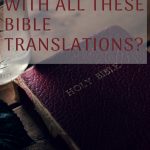Perhaps one of the most confusing things about reading the Bible in English is the plethora of different Bibles available. Not only do you have study Bibles, kid’s Bibles, journaling Bibles, etc, you also have what seems to be a never ending number of Bible translations to choose from. What’s up with all these translations? This post will strive to answer that question by giving you a “behind the scenes” peek at the Bible translation process.
Why Do All These Different Translations Exist?
The basic answer to this question is:
Translation Is … Complicated
If you’ve ever studied a foreign language, you know that a sentence in one language can be translated slightly differently when written in a different language. There are a couple of reasons for that, but one of them is that translation is not like cracking a code. You’re not just seeing a word in one language and writing down the exact match for it in another language.
Sure, some words are pretty easy to translate. “The”, for instance, is fairly simple. There is a word for “the” in Greek and it is usually translated into the English. However, different languages have different grammar rules. Greek sometimes adds a “the” when English doesn’t and vice versa. A translation that was just a one for one “code breaking” wouldn’t make much sense to the person reading it.
Beyond that, sometimes words have multiple meanings. Think about the English word “date.” We use this word to refer to a specific day on the calendar, a romantic get together, and a fruit. Hebrew, Aramaic, and Greek all have words similar to this as well. They have different meanings depending on the context. To make it more complicated, sometimes the word is being used in a way where the writer wants to you think about more than one of the meanings as you read.
Hopefully, you can see that this process can get complicated. Give a sentence from the Bible to three biblical scholars who are experts in biblical languages, and you might very well get three different translations. The basic meaning will be the same, but word choice or grammar might be slightly different.
Who Makes These Different Translations?
As a side note, you should know that all Bible translations are composed by a committee of scholars. They work together to try to come up with the best possible translation of each and every verse in the Bible. It’s painstaking work and often takes a long time because there may be disagreements about how to translate particular words or phrases. Sometimes these disagreements become “alternative readings” that are in the footnotes of your English Bible.
Different Translation Styles
Word choice and grammar aren’t the only forces at work in the different Bible translations out there. There are also different styles of translations. Basically, all of the translations fall somewhere on a spectrum of two sometimes competing factors: sticking to what the text literally says and trying to capture what the text means. Bible nerds call these two factors literal equivalency (what the words actually are) and dynamic equivalency (what the text is actually trying to say)
Literal Translation
In literal translations, the goal of the translators is to stick as close to they can to the word choice, order, grammar, etc. as they can while still trying to make the text readable. Sometimes this means that sentences can be a little awkward in English because they’re trying to stay as close as possible to the original language.
Dynamic Translation
In more dynamic translation, the translators’ goal is for their reader to be able to understand what they think the author was trying to say. They want you to grasp the thoughts and the point of the author. These translators might sometimes change a word, phrase, or grammar in an effort to make the point of the passage more clear. They stick to the original text as much as they can while still retaining the meaning. These translations are often easier to read.
However, there are places where a scholar might argue that they sacrificed the integrity of the text for readability and understanding. I would say that these instances are pretty few and far between, but they still exist in various places in the more dynamic translations.
Which Translation Is Best?
Honestly, all the translations are helpful. If you are studying a text in the Bible and you don’t know Greek, Aramaic, and/or Hebrew, looking at the same passage in different translations can help you get a better feel for what the text is actually trying to say. If a passage doesn’t make sense to you in one translation or doesn’t seem completely clear, you should always try looking at it in another translation or two.
Which translation is “best” also depends on what you’re doing. If you’re teaching children or youth, it might be best to use a more dynamic translation that they can more easily understand. If you are deeply studying a particular passage to try to understand it as best you can, you may want to look at a more literal translation, since that will be closest to the original language.
Honestly, which translation is “best” for your personal Bible reading is completely up to you. Pick the one you’re most familiar with or that you can understand most easily or that you enjoy reading most. Remember, it can always be helpful to look at another translation, but all the translations are put together by panels of scholars, are well researched, and accurately portray (as much as is possible) the Word of God.
List of the Most Popular Translations
Here’s a list of some of the most popular Bible translations. This is far from being a complete list. It’s just the ones that I have seen used/mentioned most often. For each translation, I’ll tell you where it is on the literal/dynamic scale and any other relevant information I have about it.
New International Version aka NIV
This one is pretty standard. It’s kind of middle of the road, tries to stick to what the text actually says, but will shift things around a bit to get to the best meaning. This is probably the translation that I see used most often by ministers, teachers, and in Christian books.
English Standard Version aka ESV
This one is closer literally to the original, but still tries to be readable. Very similar in objective to the NIV, even though sometimes they have slightly different translations. This is probably the second most used translation in Christian circles by ministers, authors, speakers, etc.
New American Standard Bible aka NASB
This one can get pretty awkward because it really tries to be literal. If you are trying to study a text deeply, this is actually a good one to look to because it will mirror the original language very closely.
King James Version aka KJV
This is one of the first English translations of the Bible. It was translated in the 1600s by King James (hence the name). Because it’s older, some of the language used in it is a little archaic. However, it was the standard for many, many years, so you may have memorized Bible verses from this version. This is a very literal version. However, the texts used to translate this version are no longer the standard texts used for translation. This means there may occasionally be variances between KJV and other translations.
New Living Translation aka NLT
This one is more dynamic. It’s goal is to get to the meaning of the text, even if they have to move the words around a bit. I’ve seen this one used in children’s ministry and with youth. It’s also helpful for newer believers/those who are new to the Bible.
The Message (often abbreviated MSG)
This isn’t strictly a translation, but I mention it because it’s pretty widely used. Technically, this isn’t a “translation” is a paraphrase. Basically, the author looked at the original language and tried to translate it into today’s language. His translation goal is to show how he thinks the Bible would be written today. It gets used a lot in churches and youth groups with familiar texts because it often gives a different spin to well known verses. It can be helpful when used that way, but it’s not the best if you’re looking to do deep study, at least not as your only translation. It’s also only written by one person. That is one of the main reasons why it’s not technically a translation. However that person, Eugene Peterson is a great Bible scholar who put his own understanding of the text into modern English.
If you want to learn more about the different Bible translations and see some examples of the differences between them, this link takes you to a website that I found helpful as I was thinking about this topic: http://www.apbrown2.net/web/TranslationComparisonChart.htm
How about you? Which translation do you prefer or have you seen most often? If you have any additional questions about Bible translations or the translation process, feel free to comment below. I’m happy to answer any questions you might have. Even if I don’t know the answer, I may be able to point you to some helpful resources.
Photo by Priscilla Du Preez on Unsplash


I know King James only people, and of a church that studies no Greek or Hebrew, I had heard that some translation were missing verses, dumbed down, and lots of things. I like Bible Hub, I read lots of translations and benefit from all of them, because I choose to study, and the Lord approves. Don’t judge a Bible by it’s cover, we don’t speaketh old English, and King James didn’t write it, the Holy Spirit influenced it.
Ha! King James most definitely did not write the Bible (or even the KJV). I’m glad to hear that you enjoy reading different versions. I don’t think there’s one perfect version (they all have flaws one place or another), so it’s always good to branch out!